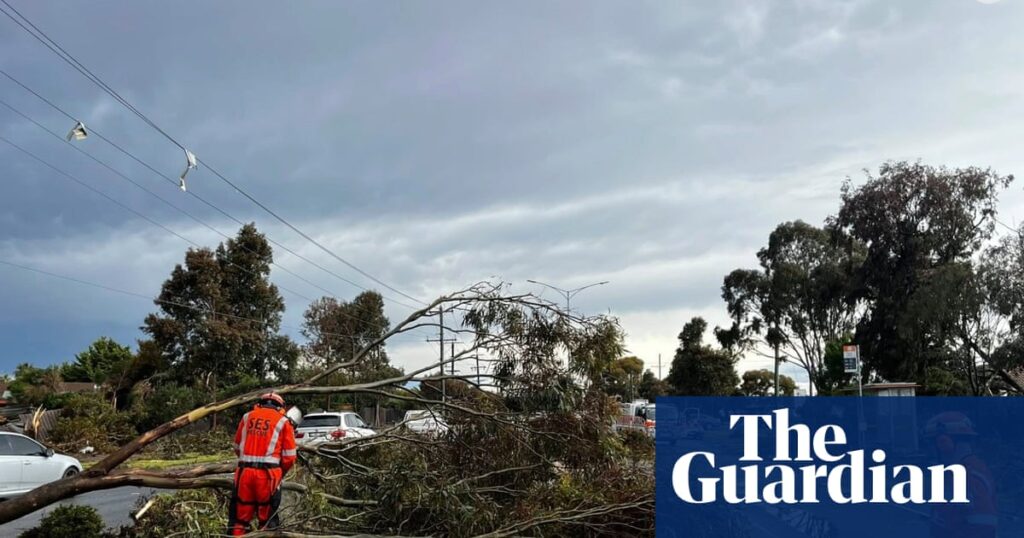About 26,000 households were without power in south-east Queensland on Monday morning after a severe thunderstorm passed over the state, with wind gusts topping 109km/h. Residents reported giant hailstones of up to 7cm in some areas.
More than 1,300 energy customers in Victoria also woke without power, after Melbourne recorded its wettest day in a year and a half. Many of those outages were resolved by early Monday afternoon.
Energex, which distributes power to 1.5m homes and businesses in south-east Queensland, said the storms had caused “significant damage”, bringing wires down across the greater Brisbane region. On Sunday night the company said almost 70 crews were working to restore power.
“This afternoon’s storm has absolutely smashed our network!” the state-owned company wrote on social media. “If you can see wires down, please stay well clear and call 000.”
The Bureau of Meteorology confirmed on Monday morning that regions across Queensland had been hit with large hailstones. Stones about 4cm in size were seen in Ipswich, 5cm in Moorooka and Goonda, 5cm to 6cm in Pullenvale and 7cm in St Lucia.
Other areas in south-east Queensland experienced severe winds, including gusts of about 95km/h in Amberley and Archerfield. Gayndah recorded gusts reaching 109km/h.
Lightning also stopped play during Sunday’s Pacific Cup Men’s rugby league match between Samoa and Tonga in Brisbane, with spectators told to move and shelter as the storm hit.
Sign up: AU Breaking News email
Damp conditions were expected to linger along much of eastern Queensland this week as a low-pressure trough continued to draw in moisture against the coast. Tuesday was forecast to be the wettest day.
In Victoria SES officials received 598 requests for assistance across the state, mostly for building damage, but also for downed trees and flooding. Many of those calls have been addressed but the SES was working on more than 100 requests on Monday morning.
The most affected suburbs were Werribee, Hoppers Crossing and Wyndham, where there were a “pretty significant” 179 calls for assistance, the SES said.
Brigette Boyd, a resident of Werribee, told ABC Radio Melbourne the storm sounded “awful”.
“As I opened the door the wind nearly blew me back so I had to close the door and stay inside,” Boyd said.
Another resident, identified as Tara, told Radio Melbourne the storm was the “sort of stuff out of a movie”. She said a 10-foot trampoline in her yard was blown “somewhere in Werribee” and that her pergola roof was stuck on nearby power lines.
“And all of a sudden, this big wind came from nowhere. It ripped off my pergola like a tin of sardines. I’m not joking,” Tara said. “My partner got lifted and dropped while me and my kids watched from the window. It was terrifying. It is literally the stuff from movies.”
after newsletter promotion
“I watched this thing like I was watching Twister. It was terrifying.”
At one point on Sunday more than 28,000 energy customers in Victoria were without power.
Melbourne was also hit by heavy rain. In the 24 hours from 9am on Sunday the city’s weather station at Melbourne Olympic Park recorded 35.4mm of rainfall, the most since April 2024, according to BoM data.
A Bom spokesperson said a “short-lived tornado” may have struck parts of Melbourne’s western suburbs, but experts are still analysing weather patterns and damage in the area to determine what took place.
“A narrow path of storm-related wind damage was observed across some western suburbs of Melbourne, including Wyndham Vale and Hoppers Crossing,” the spokesperson told Guardian Australia. “This may have been the result of a short-lived tornado, but this is unconfirmed at this point in time. Further analysis will be undertaken today.”
Victoria’s chief health officer, Dr Caroline McElnay, warned that there was an increased chance of epidemic thunderstorm asthma across the state’s northern country region.
In November 2016 Melbourne experienced the world’s largest epidemic thunderstorm asthma event, overwhelming emergency services and leading to 10 deaths.
– with AAP


